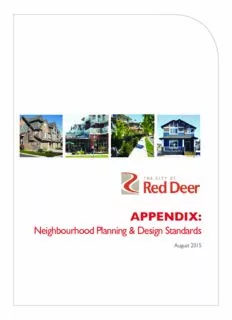
Neighbourhood Planning and Design Standards Appendix PDF
Preview Neighbourhood Planning and Design Standards Appendix
APPENDIX: Neighbourhood Planning & Design Standards August 2015 Table of Contents 1 . Document Overview 3. Appendix A: Land Use Allocation, Housing Mix & Density 7. Appendix B: NASP Process 8. Appendix C: NASP Template 73. Appendix D: Checklist/Evaluation 101. Appendix E: Fees NEIGHBOURHOOD PLANNING & DESIGN STANDARDS 1 . Document Overview The following is an appendix to the Neighbourhood Planning and Design Standards. The purpose of this appendix is to provide additional information and guidance for preparation and submission of a Neighbourhood Area Structure Plan 1 NEIGHBOURHOOD PLANNING & DESIGN STANDARDS Appendix A: Land Use Allocation, Housing Mix & Density Land Use Allocation Table Template The template below is intended for calculating land use allocation in primarily residential areas and not mixed use commercial/residential areas. Table 1. Net Developable Area Land Use Category / Component Area (Ha) Gross Plan Area (minus) Environmental Reserve Major Streets (arterials) Commercial Sites Industrial Uses High Schools & Sportsfields additional to MR Special Land Use as determined by the City Constructed Wetlands (Net) Developable Plan Area: Table 2. Residential Land Use Residential Land Use Area (Ha) % of Net Number of Developable Dwelling Units Area R1 Residential (Low Density) R1C Residential (Carriage Home) R1WS Residential (Wide/Shallow Lot) R1A Residential (Semi-Detached Dwelling) R1N Residential (Narrow Lot) R1G Residential (Small Lot) RLW Residential (Live-Work) R2 Residential (Medium Density) 3 NEIGHBOURHOOD PLANNING & DESIGN STANDARDS R2T Residential (Town House) R3 Residential (Multiple Family) R4 Residential (Manufactured Home) R1E Residential Estate Other residential types, add here. Total Residential: Table 3. Commercial Land Use Area (Ha) % of Net Developable Number of Area Commercial Units C2A Commercial (Regional Shopping Centre) C2B Commercial (District Shopping Centre) C3 Commercial (Neighbourhood Convenience) C4 Commercial (Major Arterial) C5 Commercial (Mixed Use) Table 4. Industrial Land Use Industrial Land Use Area (Ha) % of Net Developable Number of Industrial Area Units I1 Industrial (Business Service) I2 Industrial (Heavy Industrial) I1A/BSR (Light Industiial and Business Service-Residential) 4 NEIGHBOURHOOD PLANNING & DESIGN STANDARDS Table 5. Other Land Uses Other Land Uses Area (Ha) % of Net Developable Area Community Amenity Sites Temporary Care/Day Care/ Assisted Living Place of Worship Other proposed community amenity sites, add here Open Space Municipal Reserve (MR) Public Utility Lot (PUL) Environmental Reserve (ER) Transportation Collector Streets Local Streets Lanes Other Uses Emergency Service Site (ES) Institutional Service Facility (PS) Other uses, add here 5 NEIGHBOURHOOD PLANNING & DESIGN STANDARDS Notes: 1) Gross plan area is the total area of the NASP 2) Developable plan aera is used for the density calculation. Developable plan area is the gross plan area, less land for ER; major roads (expressways and arterials); commercial sites; industrial uses; high schools and sportsfields additional to municipal reserve land dedicated for these purposes; and, as determined by The City, special land use sites, constructed wetlands and retention (wet) ponds, or portions thereof, that have high aesthetic values. 3) The number of mixed residential / commercial dwelling units is not included in the total residential calculation. Separate mixed used residential / commercial density ranges are outlined in the MASP and corresponding area redevelopment plan. 4) MR is a percentage of the gross plan area less the ER. 5) Density is measured in the number of dwelling units per developable plan area measured in hectares (du/ha) 6) Assumptions for dwelling unit density projections (intended as general guidelines): a) Lots for conventional detached dwellings and detached dwellings with secondary suites are assumed to be on average 464 square metres with frontages of 13.25 metres and lot depths of 35 metres. b) Lots for narrow lot detached dwellings are assumed to be on average 381 square metres with frontages of 10.40 metres and lot depths of 36.6 metres. c) Lots for semi-detached dwellings are assumed to be on average 595 square metres with frontages of 16.0 to 19.0 metres (minimum of 7.6 metres per unit and lot depths of 35 metres. d) Low rise multi-family site density is assumed to be generally 35 dwelling units per hectare. The acutal density is not prescribed in the LUB and is determined by the Development Authority at the time of development permit approval. Depending on the actual densities achieved on the multi-family sites the neighbourhood density may vary slightly from the calculated densities. 6) Multi-family dwelling units’ means three or more attached dwelling units. 6
Description: